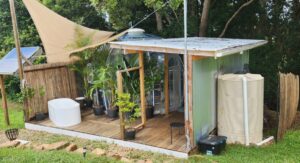The Ultimate Guide to Starting a Glamping Business

The allure of the great outdoors combined with the comfort of luxury accommodations has given rise to a booming trend known as “glamping”—a portmanteau of glamour and camping. Glamping offers a unique experience for those who want to immerse themselves in nature without sacrificing the comforts of a hotel. For entrepreneurs seeking to capitalize on this growing trend, starting a glamping business can be a rewarding venture. This guide will walk you through the most important elements of establishing a successful glamping business.
1. Understanding the Market
Before diving into the glamping business, it’s essential to understand the market landscape. Glamping appeals to a diverse demographic, including millennials seeking Instagram-worthy experiences, families looking for unique vacation options, and older travelers who desire comfort in nature. Conduct thorough market research to identify your target audience, their preferences, and the competitive landscape. Analyze successful glamping operations to understand what works and how you can differentiate your offering.
2. Choosing the Right Location
Location is one of the most critical factors in the success of a glamping business. The site should offer natural beauty, tranquility, and accessibility. Consider proximity to local attractions, such as national parks, hiking trails, or lakes, which can enhance the guest experience. Additionally, evaluate the climate, seasonal weather patterns, and environmental regulations. Ensure that the location aligns with your target audience’s interests and provides opportunities for various outdoor activities.

3. Crafting a Unique Experience
In the competitive world of glamping, offering a unique and memorable experience is crucial. Start by choosing accommodation types that reflect the luxury and adventure your target audience desires. Options range from safari tents and yurts to treehouses and airstreams. Focus on interior design, incorporating high-quality furnishings, stylish decor, and essential amenities like comfortable beds, private bathrooms, and kitchen facilities.
Beyond accommodation, curate activities and services that enhance the overall experience. This could include guided hikes, stargazing sessions, cooking classes, or wellness retreats. Partner with local businesses to offer unique experiences, such as wine tastings or cultural tours, which can add significant value to your guests’ stay.
4. Navigating Legal and Regulatory Requirements
Starting a glamping business involves navigating various legal and regulatory requirements. These may include zoning laws, building permits, health and safety standards, and environmental regulations. It’s crucial to research and comply with all relevant laws to avoid legal issues. Consulting with a legal expert, town planner or local authorities can provide valuable insights and ensure you meet all necessary requirements. Additionally, consider obtaining insurance coverage to protect your business from potential liabilities.
5. Developing a Business Plan
A well-structured business plan is essential for guiding your venture and securing financing. Your plan should outline your business model, target market, marketing strategies, operational plan, and financial projections. Detail your startup costs, including land acquisition, construction, permits, and furnishings. Consider both short-term and long-term goals, and establish key performance indicators to measure success. A comprehensive business plan not only helps you stay organized but also serves as a valuable tool when seeking investors or loans.
6. Building and Designing Your Site
The design and construction of your glamping site are critical to delivering a high-quality experience. Work with architects and builders experienced in eco-friendly and sustainable construction. Use materials and designs that minimize environmental impact while maximizing comfort and aesthetics. Consider energy-efficient solutions, such as solar power, rainwater harvesting, and composting toilets, to appeal to environmentally conscious travelers. Landscaping should enhance the natural beauty of the site, providing privacy and serenity for guests.
7. Marketing and Promotion
Effective marketing is key to attracting guests to your glamping business. Develop a strong brand identity that resonates with your target audience. Use social media platforms, such as Instagram and Facebook, to showcase stunning visuals of your site and engage with potential customers. Invest in a professional website with easy booking functionality and comprehensive information about your accommodations and services. Leverage online travel agencies and glamping-specific platforms to increase visibility.
Consider content marketing strategies, such as blogging about travel tips, local attractions, and glamping lifestyle, to drive traffic to your website. Collaborate with influencers and travel bloggers to reach a wider audience. Additionally, encourage satisfied guests to leave positive reviews and testimonials, which can significantly boost your reputation and attract new visitors.
8. Providing Exceptional Customer Service
Customer service is a critical component of a successful glamping business. From the initial booking process to post-stay follow-ups, ensure that every interaction with your guests is positive and memorable. Train your staff to be attentive, friendly, and knowledgeable about the local area. Personalize the guest experience by offering tailored recommendations and accommodating special requests. Collect feedback regularly to identify areas for improvement and enhance overall guest satisfaction.
9. Managing Operations and Maintenance
Efficient operations and maintenance are essential for the smooth running of your glamping business. Develop a detailed operations plan that outlines daily tasks, staff responsibilities, and maintenance schedules. Regularly inspect and maintain accommodations to ensure they remain in excellent condition. Implement a reservation management system to streamline bookings, payments, and guest communications. Consider seasonal adjustments to your offerings and staffing levels to optimize efficiency and profitability.
10. Embracing Sustainability
Sustainability is becoming increasingly important to travelers, and embracing Eco-friendly practices can set your glamping business apart. Focus on minimizing waste, conserving energy and water, and supporting local ecosystems. Offer educational programs or workshops on sustainability to engage guests and raise awareness. By prioritizing sustainability, you not only contribute to environmental conservation but also attract a growing segment of Eco-conscious travelers.
In conclusion, starting a glamping business requires careful planning, creativity, and dedication. By understanding the market, choosing the right location, and crafting a unique experience, you can create a successful venture that captures the hearts of travelers seeking a harmonious blend of nature and luxury. With the right strategies and commitment to excellence, your glamping business can thrive in this exciting and dynamic industry.
Our Glamping Experience
Here at Lucidomes Australia, we have had real experience in operating a glamping business on the Gold Coast hinterland operating a Lucidome.
We chose a very private site in nature. The Lucidome is mounted on a timber deck large enough to incorporate a mini kitchen, shower, compost toilet and outside bath (the outside bath is very popular with couples.
After operating for about 6 months the occupancy rate contributed to a highly profitable return indicating approximately 60% gross annual return on the capital cost.
Every facility is different with many different factors influencing popularity, occupancy rates and more.
One thing we know is that in the right location with the right set-up, with good management and the best of hospitality service, it is possible to make exceptional returns on capital with a Glamping Business.

